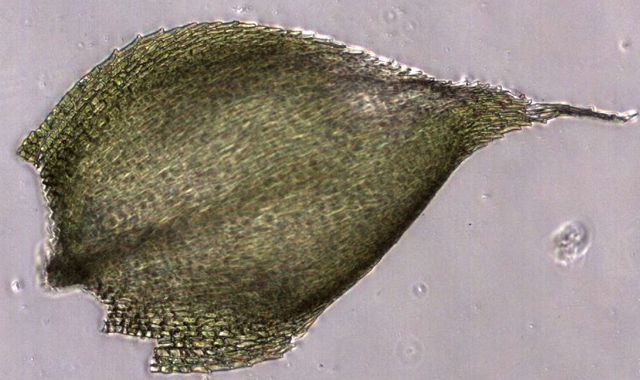Plants in thin mats, glossy green, often with a russet cast. Stems prostrate, julaceous, to 6 cm long, irregularly branched with branches not strongly differentiated from stems. Leaves imbricated, patent to weakly spreading when dry but erect-spreading when moist, not or very little falcate secund, to 1 mm long, 3–4: 1, lanceolate to ovate-lanceolate, not plicate, with a well-defined, reflexed acumen. Branch leaves smaller, narrower and more falcate-secund than the stem leaves. Margins plane or minutely recurved below, strongly decurrent to base of next leaf, serrulate below but usually serrate above. Median cells smooth, to 8 µm wide, linear, 8–10: 1, thin-walled, not pitted. Alar cells rather numerous in a moderately well-defined group, quadrate to short rectangular with walls rather thick and somewhat pitted. Apical cells elongate, not differentiated. Costa extending to about 1/2 with a prominent abaxial spine. Pseudoparaphyllia deltoid to orbicular, strongly overarching the bud. Axillary hairs of 3 similar cells, to 80 µm with no basal brown cells, not offset from leaf insertion. Rhizoids red-brown, to 10 µm, smooth, as scattered fascicles on ventral portion of prostrate stem.
Dioicous with male plants similar to females. Perichaetial bracts costate, abruptly acuminate from a ligulate-lanceolate base with the acumens loosely spreading, cells uniformly long and straight to 20: 1. Seta red-brown, smooth, to 1.2 cm long. Capsule brown to yellow brown, inclined to horizontal, strangulate when dry. Urn to 1.8 mm, oblong and asymmetric, mostly less than 2: 1. Exothecial cells not in regular vertical rows, to 25 µm wide, mostly isodiametric but some to 3: 1, with thick, red-brown lateral walls and with stomata restricted to neck. Operculum bluntly conic, about 1/3 as long as urn. Annulus differentiated, not revoluble. Exostome to 450 µm long, horizontally striate below, papillose above, yellow brown. Endostome segments low papillose, open on keel, about as long as exostome with basal membrane about equal in length to the segments. Cilia 1–2, nodose. Spores smooth to finely papillose, to 15 µm.
| Literature | Flowers 1973; Harthill et al. 1979; Holmberg 1969; Howe 1896; Koch 1950a, 1951e, 1958; Lawton 1971; Long 1978; McGrew 1976; Showers 1982; Spjut 1971; Strid 1974. As Hypnum collinum & H. hillebrandi Lesquereux 1868; Watson 1880. |
| Illustrations | Malcolm et al. 2009 p. 257; Flowers 1973; Ignatov 1998; Lawton 1971; Sharp et al. 1994. |
| Bioregions | DMoj, NW, SN, SNE, SW. |
| Vouchers | Fresno Co.: north face of Spanish Mountain, John Muir Wilderness, Sierra National Forest, Shevock & York 12421; Inyo Co.: slopes of Rogers Peak, Death Valley National Park, Shevock, York, & Davis 21367; Lake Co.: Summit Springs Trail, Snow Mountain Wilderness, Mendocino National Forest, Toren & Dearing 7464 (CAS); San Bernardino Co.: Dollar Lake Trail, San Gorgonio Wilderness, San Bernardino National Forest, Harpel 2188 (pers. herb.); Tuolumne Co.: White Wolf, Yosemite National Park, Kellman 499 (CAS). |
·
![University of California [UC]](http://ucjeps.berkeley.edu/common/images/logo_uc_80.png)
![University of California [UC]](http://ucjeps.berkeley.edu/common/images/logo_uc_80.png)
